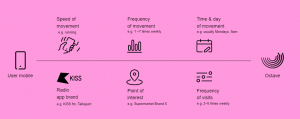 The audio advertising landscape has come a long way from just being the ‘black box’ in the corner of the room, and with the increased adoption of digital audio, it is now one rife with innovation and disruption. The latest IAB ad spend report places digital audio growth at 58% between 2020 and 2021 worth over £164m and Statista expects it to hit over £250m by 2025. Challenges such as the dissolution of the 3rd party cookie (forever pushed back), Windowless smart devices and complex consent concerns keep the industry on its toes.
Octave is no stranger to these challenges and we are always on the lookout for new and innovative solutions for our clients. One of these solutions is our Smart Contextual suite, launched in early 2022 we have been adding more and more features, here are three ways you can get the best out of them;
The audio advertising landscape has come a long way from just being the ‘black box’ in the corner of the room, and with the increased adoption of digital audio, it is now one rife with innovation and disruption. The latest IAB ad spend report places digital audio growth at 58% between 2020 and 2021 worth over £164m and Statista expects it to hit over £250m by 2025. Challenges such as the dissolution of the 3rd party cookie (forever pushed back), Windowless smart devices and complex consent concerns keep the industry on its toes.
Octave is no stranger to these challenges and we are always on the lookout for new and innovative solutions for our clients. One of these solutions is our Smart Contextual suite, launched in early 2022 we have been adding more and more features, here are three ways you can get the best out of them;
3 Targeting Tips to Supercharge your Digital Audio Campaigns
Thursday 18 August 2022
 The audio advertising landscape has come a long way from just being the ‘black box’ in the corner of the room, and with the increased adoption of digital audio, it is now one rife with innovation and disruption. The latest IAB ad spend report places digital audio growth at 58% between 2020 and 2021 worth over £164m and Statista expects it to hit over £250m by 2025. Challenges such as the dissolution of the 3rd party cookie (forever pushed back), Windowless smart devices and complex consent concerns keep the industry on its toes.
Octave is no stranger to these challenges and we are always on the lookout for new and innovative solutions for our clients. One of these solutions is our Smart Contextual suite, launched in early 2022 we have been adding more and more features, here are three ways you can get the best out of them;
The audio advertising landscape has come a long way from just being the ‘black box’ in the corner of the room, and with the increased adoption of digital audio, it is now one rife with innovation and disruption. The latest IAB ad spend report places digital audio growth at 58% between 2020 and 2021 worth over £164m and Statista expects it to hit over £250m by 2025. Challenges such as the dissolution of the 3rd party cookie (forever pushed back), Windowless smart devices and complex consent concerns keep the industry on its toes.
Octave is no stranger to these challenges and we are always on the lookout for new and innovative solutions for our clients. One of these solutions is our Smart Contextual suite, launched in early 2022 we have been adding more and more features, here are three ways you can get the best out of them;

Head of Product & Strategy

